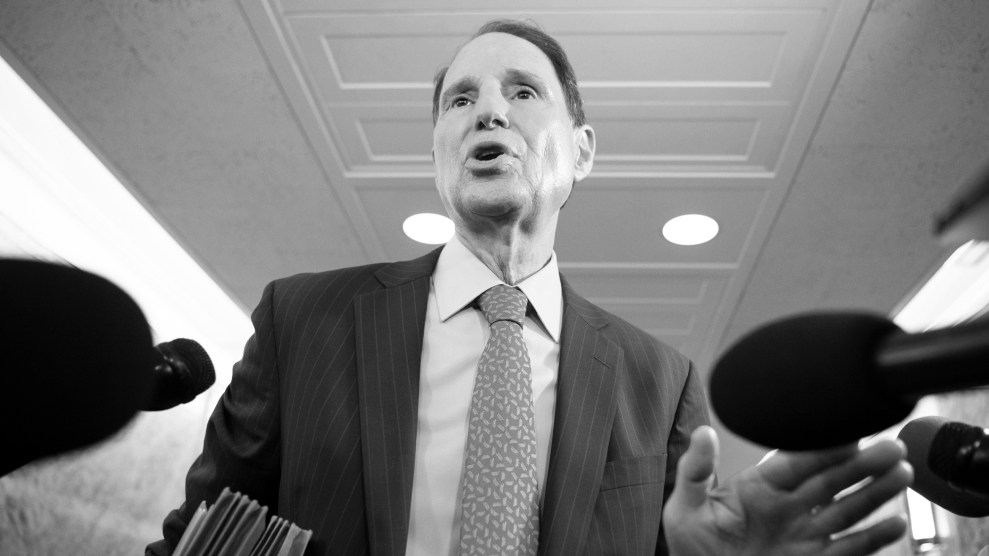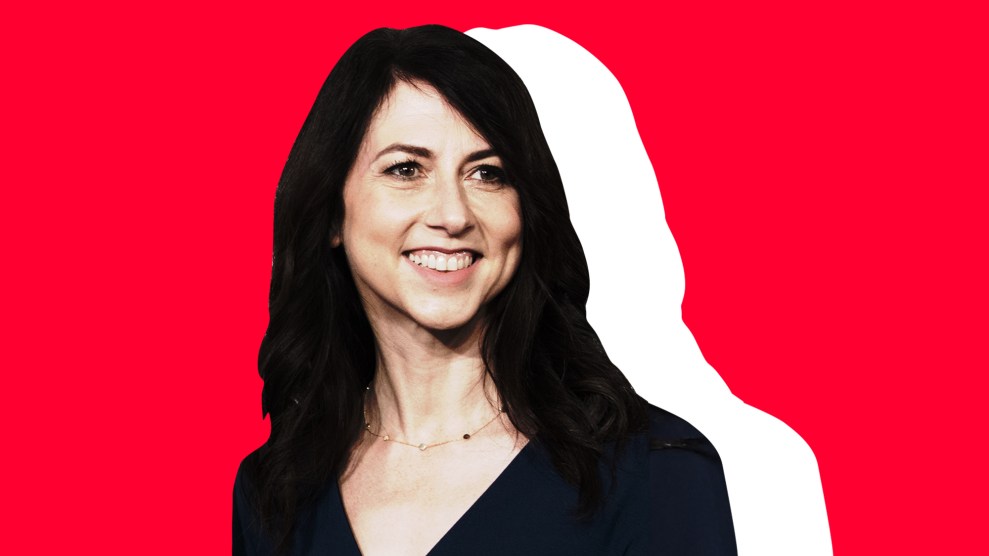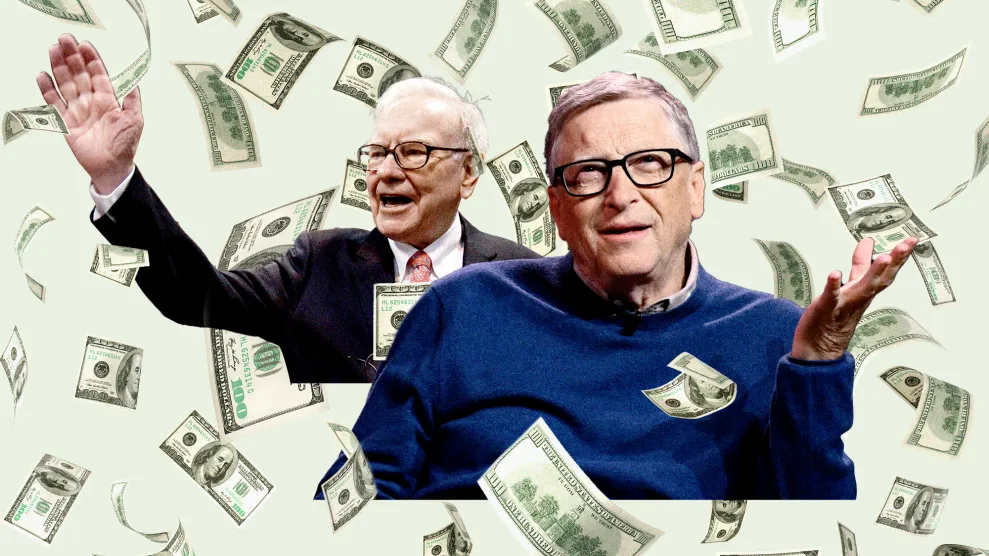
Mother Jones; Nati Harnik/AP, Evan Agostini/Invision/AP; Getty
As the author of a book about runaway wealth in America, I’ve thought a fair bit about the Giving Pledge, the exclusive do-gooder club Bill and Melinda French Gates launched in 2010 with their pal Warren Buffett and 37 other billionaires, all vowing to give away the majority of their fortunes.
Now that the pledge has been around more than a decade, one can reasonably ask what progress its members have made toward their goal. As we’ll soon see, most of them have made very little.
In some respects, the whole enterprise feels like a bit of a scam. Not in the legal sense—though at least one former pledger was recently convicted of financial fraud and a current member took a federal plea deal to escape prosecution for the same.
I mean a scam in the sense of a self-selected group of excessively wealthy people—some of whom have made their fortunes in problematic ways and likely most of whom have used extreme strategies to avoid taxation—burnishing their reputations even as they exercise undemocratic influence over matters of public interest.
And maybe they stick to the pledge and maybe they don’t—or maybe they stick to it by bankrolling very, very bad causes. Because the Giving Pledge asks neither where its members’ money came from nor where it’s going.
The pledge, its organizers concede, is “a moral commitment…not a legal contract,” so signatories are not held to their promise. Only about 1 in 13 of the world’s billionaires are “members,” and most will remain billionaires after giving away the “majority” of their wealth, which is half plus a penny.
To date, 241 extraordinarily rich individuals and couples from 29 countries have signed up—or 243 if you include the rejects. Those include the above-referenced crypto bro, Sam Bankman-Fried, whose net worth plummeted from a peak of $26.5 billion to about $4 million, and T. Denny Sanford, an early pledger who made his fortune peddling high-interest credit cards to hard-up borrowers.
Sanford had given generously to kids’ programs, but was quietly removed as a Giving Pledge member last year, after ProPublica reported that investigators had found nude photos of children in one of his email accounts. (No charges were filed.)
One big inspiration for the pledge was the late billionaire Chuck Feeney, who is revered by Buffett and Gates, and is the only pledger I know of who has given away not just a majority of his fortune but nearly all of it. (Only MacKenzie Scott appears on track to replicate that feat.) In his bestselling biography, The Billionaire Who Wasn’t, author Conor O’Clery writes that Feeney agreed to join the pledge reluctantly. He wasn’t an attention seeker, and after a quarter-century of stealthy giving, he was no longer a billionaire either.
The pledge was also, like the rest of America’s philanthropy-industrial complex, inspired in part by Andrew Carnegie, the Gilded Age steel baron who argued in his widely read 1889 essay, The Gospel of Wealth, that captains of industry such as he must dispense with their excessive fortunes for public benefit within their lifetimes, or else die “disgraced.”
The Giving Pledge is only Carnegie-lite, however, because its members are allowed to fulfill their promise—or not—in either life or death, and hang onto half of their hoards. Carnegie, who followed his own counsel by building universities and research institutions and thousands of libraries in the United States and abroad, would no doubt consider the pledge weak tea.
In any case, given the rate at which billionaires’ fortunes expand—which has much to do with the way our government taxes investments and offers retirement subsidies and tax-avoidance opportunities to people who can afford $1,000-an-hour lawyers—their assets pile up faster than they can realistically dispense with them.
So how are the pledgers faring? Let’s take a look.
In the latest report on billionaire philanthropy from the nonprofit Institute for Policy Studies, authors Helen Flannery, Chuck Collins, and Bella DeVaan use Forbes data to calculate that the 73 surviving American pledgers who were billionaires when the pledge was created in 2010 have more than doubled their collective wealth since then—and 30 individuals have seen their net worths at least triple. Behold the greatest hits. (Hard to believe, but Elon Musk wasn’t a billionaire in 2010.)
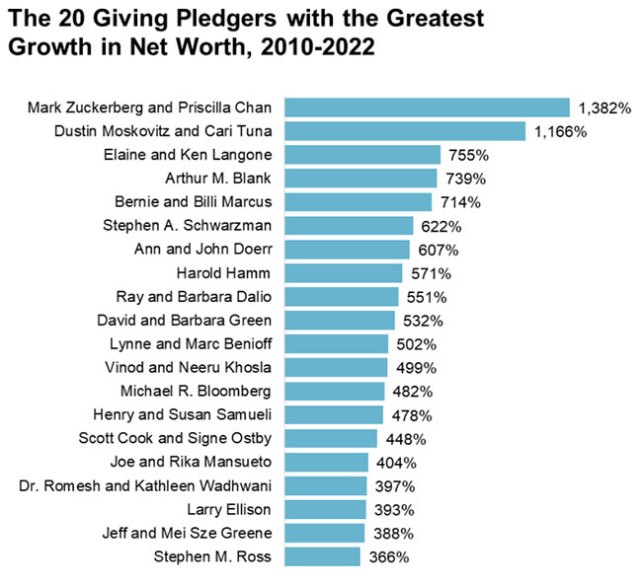
I used Forbes data (some of which IPS provided) to ask a slightly different question, namely: How rich are the longest-standing (decade-plus) American pledgers today vs. the year they signed up?
Based on my calculations, at least 60 percent of those 75 pledgers are worth as much or more now, after adjusting for inflation, as they were back then. One-third have seen their wealth double or more. Eighteen saw it triple, nine saw it quadruple, and (aptly) five saw their wealth at least quintuple. The three biggest winners were Quicken Loans co-founder Daniel Gilbert and his wife, Jennifer (+10.5x), Mark Zuckerberg and Priscilla Chan (+21.1x), and good old Elon (+91.2x).
And what of Bill Gates, whose name has become synonymous with philanthropy (among other things)? In 2014, Gates published a review of Capital in the 21st Century, French economist Thomas Piketty’s bestselling book about inequality. Gates wrote: “I fully agree that we don’t want to live in an aristocratic society in which already-wealthy families get richer simply by sitting on their laurels and collecting what Piketty calls ‘rentier income’—that is, the returns people earn when they let others use their money, land, or other property. But I don’t think America is anything close to that.”
Gates, whose fortune at the time was $76 billion (about 99 billion in today’s dollars), must have been suffering from rich-man delusions. Because America was already fully immersed in the scenario he described, thanks to decades of tax cuts for the rich that resulted in a top-heavy wealth distribution unseen since the Gilded Age. Here are two charts from my book. (The lines in the bottom chart represent families from the richest 1 percent, richest 10 percent, and the US population as a whole.)
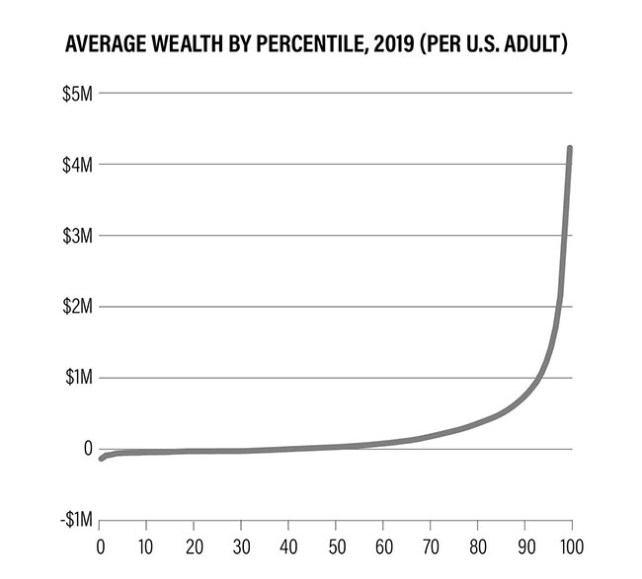
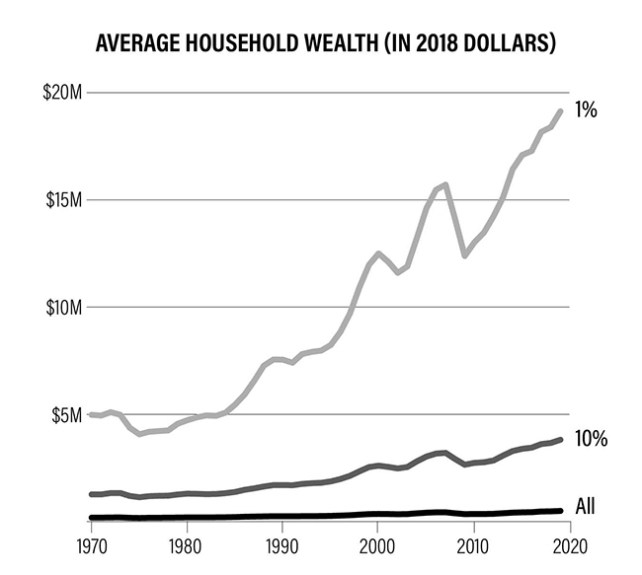
It is true that Gates has put extraordinary sums into his charitable pursuits. From 2010–2022, per IRS documents, some $66.1 billion has flowed from his accounts and trusts into the Bill and Melinda Gates Foundation. So let’s interrogate that a bit.
First, the couple has received extraordinary tax breaks for those contributions, and the foundation’s tax-exempt activities are heavily subsidized. The Gateses’ largesse, meanwhile, hasn’t even made a dent in “the corpus,” the hive of family assets whence all the honey flows—and there’s a lot of honey flowing. During that same time period, the combined net worths of Bill Gates and Melinda French, who divorced in 2021, soared by more than $82 billion—from $53 billion in 2010 to $135.2 billion in 2022, per Forbes data.
As of November 27, Forbes had Bill’s wealth pegged at $117.2 billion and Melinda’s at $10.2 billion. Which means, even with all their giving, their collective, inflation-adjusted wealth is now 171 percent of what it was when they launched the pledge.
The IPS notes that only “a tiny handful” of the pledgers it scrutinized had either given away half their assets or publicly announced that they’d arranged to do so in their estate plans. What’s more, most of their donations haven’t gone directly to charities—as MacKenzie Scott’s have—but to their own foundations and donor-advised funds (DAFs).
That makes a huge difference. Private foundations and DAFs—a fast-growing alternative vehicle—have become repositories for a truly massive trove of publicly subsidized but unspent philanthropic assets. At the end of 2019, the IRS estimates, there were more than 103,000 private foundations with assets totaling more than $1.1 trillion—almost three quarters of which was controlled by foundations worth $50 million or more. At the end of last year, DAFs held $229 billion in assets, more than double the 2017 total.
Neither foundations nor DAFs receive much oversight, despite the epic tax breaks their creators enjoy. In 2021, for example, Musk gifted his foundation $5.7 billion, mostly Tesla stock, a donation that, according to one Bloomberg op-ed writer, may have saved him up to $4.6 billion in state and federal taxes.
Such numbers add up. The tax deduction for charitable donations—which goes mainly to the wealthiest 10 percent of taxpayers—costs the federal government $56 billion per year in revenue, and state and local governments sacrifice tens of billions more. Throw in other types of tax breaks, the IPS authors say, and we’re talking hundreds of billions of dollars a year in subsidies.
In exchange for their (largely) tax-exempt status, private foundations are required to spend at least 5 percent of their assets each year on charitable pursuits—which includes overhead. Most hew close to this bare minimum. Over the past five years, the IPS calculates, median payout rates for foundations worth $1 billion or more have ranged from 4.6 and 5.4 percent.
Worse yet, those minimum payouts include compensation foundations provide to their creators’ family members who serve as employees or trustees—the du Pont chemical dynasty’s Longwood Foundation pays its president (and founder’s namesake), Éleuthère Irénée du Pont II, more than $350,000 a year. Also deductible, bizarrely, are grants a foundation makes to its creator’s own donor-advised funds.
From 2016 through 2020, for example, more than 80 percent of the Musk Foundation’s roughly $98 million in “charitable gifts” went to Vanguard Charitable or Fidelity Charitable, which host individual DAFs, presumably including Musk’s. It’s an “unfortunate loophole,” Harvey Dale, who served 20 years as president and CEO of Chuck Feeney’s now-shuttered Atlantic Foundation, told me in an email.
The paltry payouts, in any case, are more than matched by incoming revenues (dividends, rents, etc) and the swelling value of foundations’ untaxed investment assets. As I pointed out in Jackpot, private foundations overall expended roughly 6 percent of their assets in 2019—a year in which the S&P 500 clocked a 29 percent gain. The following year, amid the pandemic, a coalition of wealthy progressives launched a campaign imploring Congress to impose a 10 percent payout minimum on foundations and DAFs alike. Response: crickets.
The glacial pace of foundation giving would seem to violate the spirit of the Giving Pledge. Consider the late Intel founder Gordon Moore and his wife, Betty. According to IPS, they established their foundation in 2000 with a $5 billion gift, almost two-thirds of their net worth at the time, but made no further contributions. Two decades later, at the end of 2021, their foundation reported net assets in excess of $9.5 billion. Its giving “has mirrored the deliberate pace of [the Moores’] personal giving,” the authors write, “generally treating the 5 percent minimum payout requirement as a ceiling, rather than a floor.”
Donor-advised funds, even less regulated, have no mandatory payout. They also have a transparency problem—or benefit, depending on where you sit. Whereas foundations must reveal their beneficiaries to the public, DAFs have no such requirement. So if your charity consists of bankrolling dark-money nonprofits like the Federalist Society or “educational” nonprofits that spread disinformation about climate science, nobody will be the wiser. Which is undoubtedly one reason they’ve grown so popular.
The IPS lauds a handful of pledgers, including Scott, Salesforce’s Marc Benioff, and Ted Turner, and takes aim at others, like Oracle’s Larry Ellison, who has said he’d give away “at least 95 percent” of his (as of Monday) nearly $150 billion fortune but to date has doled out but a tiny fraction, and has a spotty foundation track record to boot. There’s also billionaire Patrón Spirits co-founder John Paul DeJoria, whose Peace, Love, and Happiness Foundation, IPS estimates, has given out just $26 million since its inception in 2011.
Aviation safety mogul Albert Lee Ueltschi signed the pledge in 2012, just a month before he died, according to IPS, but he moved about half of his $4 billion into a trust for his inheritors and ended up giving only $460 million to charity.
Chase Manhattan CEO David Rockefeller also fell short of giving a majority. He’d said he planned to give the bulk of his wealth to charity at death, the IPS notes, but when he died in 2017, most of his remaining $3.3 billion in assets “were held in trusts for his children and only about $700 million was left to give out to charity. All told, Rockefeller gave away an estimated $1.7 billion over the course of his lifetime and in his will,” the report says.
Texas oil billionaire George P. Mitchell must have harbored some guilt, because he contributed millions to environmental groups. But IPS estimates that Mitchell gave away only $596 million in life and death—about one-fifth of his final net worth.
Nope. Andrew Carnegie would not like this one bit.
Correction: An earlier version of this story said Betty and Gordon Moore were both deceased. Betty is still among us.


